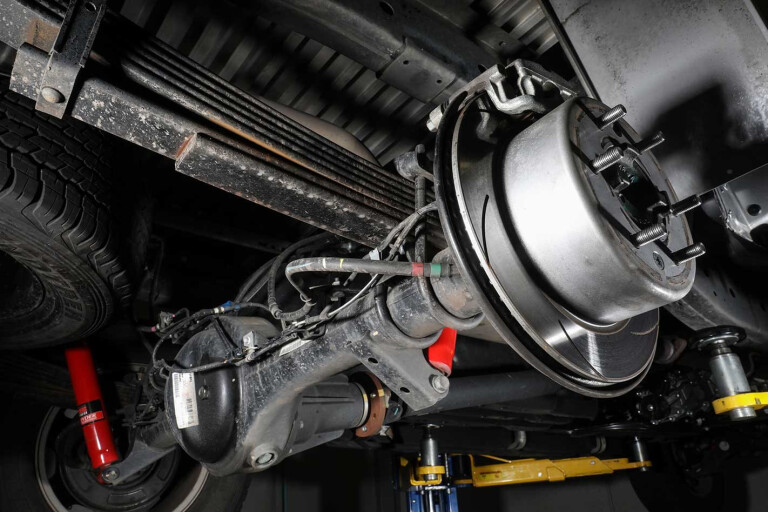
IF YOU SAT down and thought about what’s required in a modern, four-wheel-drive ute with a GVM of 3200kg and a towing capacity of 3500kg, it’s a fair bet that one of the elements you’d probably be including would be a disc brake on each wheel.
Yet, largely for reasons of cost-containment, the big-selling current-model dual cabs don’t. The manufacturers have stuck with a drum-braked rear end and that’s your lot. Take it or leave it.
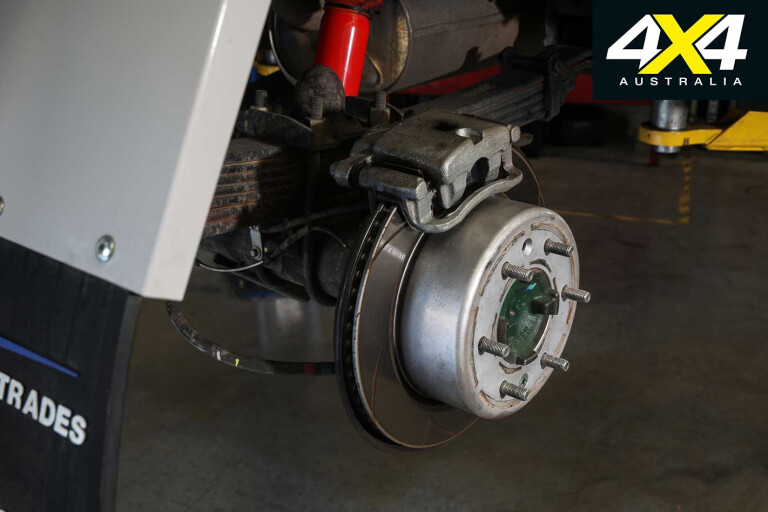
However, consider the advantages of a disc-brake rear-end on something like a Ford Ranger or Toyota Hilux. Shorter stopping distances is the obvious one, especially when you’re heavily loaded or towing a big tandem with a Bobcat on the back.
Aside from quicker, shorter stops, though, a disc-brake setup will typically give greater fade resistance, a bonus for those who operate in hilly country or just making multiple stops.
Off-road, a slotted disc-brake rotor isn’t affected by mud or water ingress like a drum brake is, and then there’s the matter of all those clever electronics that give modern four-wheels drives such brilliant low-grip ability.
By combining the characteristics of both anti-lock braking and electronic stability control, today’s dual cabs can provide the sort of grip and traction that it once took front and rear diff locks to produce. In fact, in testing we’ve done here at 4X4 Australia, the modern electronic methods sometimes produce superior traction to conventional lockers.
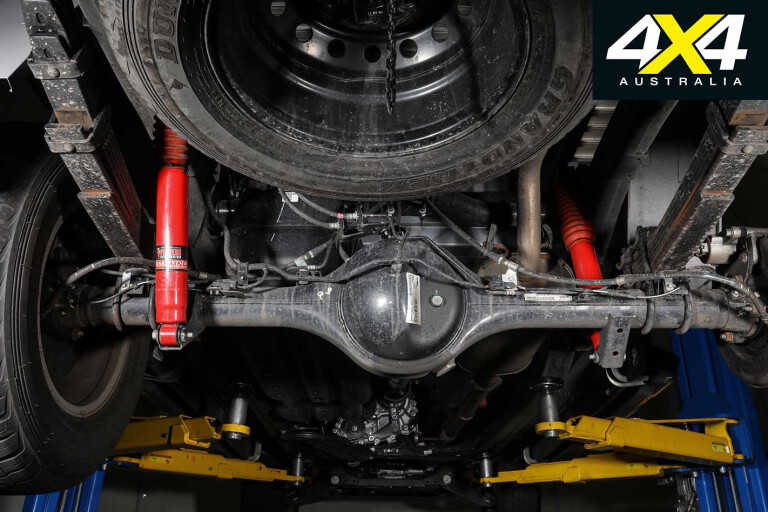
The catch with this is that the electronic systems, thanks to their constant cycling of the brakes to maintain traction, can get the hardware awfully hot, awfully quickly. But if you had a disc-braked rear-end which is far better at radiating heat (that fade resistance thing again) then these electronic traction aids could potentially work better for longer.
So a rear-axle disc-brake conversion seems like a pretty good idea, and that’s where Pedders comes in. The brains trust at Pedders have come up with a kit that takes a Ford Ranger (and its twin, the Mazda BT-50), Toyota Hilux or Isuzu D-Max from drums to discs at the blunt end.
The kits can be fitted at any mechanical workshop or, if you’re the fairly handy type, you could fit it yourself.
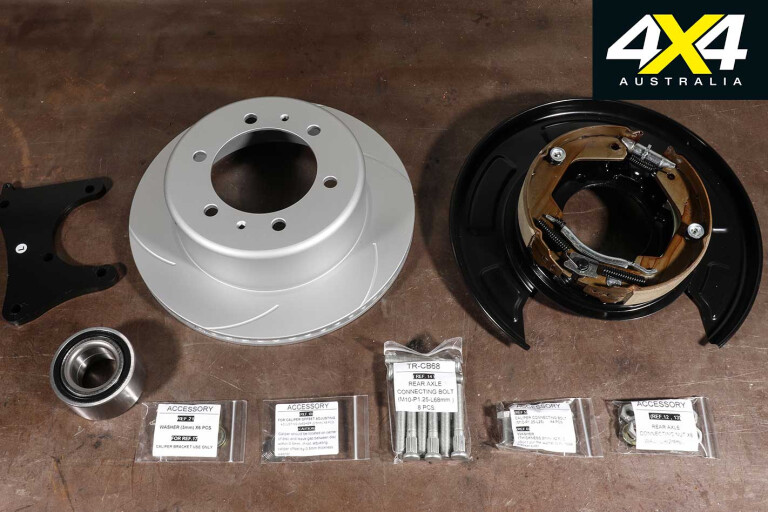
So what do you get? In a nutshell, everything from the hardware to the instructions, right down to the fasteners, all bagged up and labelled to make it as simple as possible. That includes the slotted one-piece rotors, a pair of calipers, Kevlar-ceramic pads, the park-brake setup, backing plates and brackets.
It’s important to note, too, that this isn’t a collection of everybody else’s part numbers. No, every piece has been engineered to Pedders’ own specifications and manufactured exclusively. This has enabled Pedders to get away without fiddling with master cylinders, proportioning valves and other settings.
Because the calipers have been designed with the OE front brakes as a known quantity, the brake bias can be established and fixed via the rear caliper-piston size itself. Crucially, the ABS operation is not affected, either.
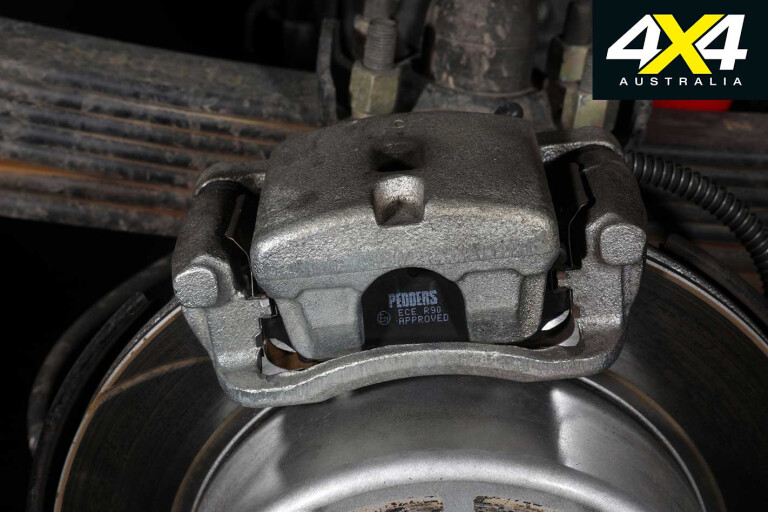
The park-brake is now an expanding-shoe arrangement, incorporated into the rotor’s top-hat, just like a drum park brake. This is to give the maximum swept area to hold the vehicle against static loads, and testing has shown that the entire setup exceeds all ADR requirements.
In fact, the whole setup has been tested beyond all statutory performance targets and, in in-house testing, has shown that a fully loaded Ranger, from 100km/h, will stop an average of 14 metres shorter with the conversion kit fitted than the stock vehicle. And the more you load it, the bigger that difference will theoretically become. Then throw in multiple stops in quick succession and the kit should widen the performance gap further.

The kit is designed as a straight bolt-on deal, and Pedders reckons there’s been plenty of overseas interest in the setup (since the vehicles it covers are all global ones). There’s a warranty of two years or 40,000km on the Pedders gear, and the only thing to do beyond bolting it on is to have the modified vehicle independently engineered to eliminate insurance and registration hassles (budget on between $400 and $600 for this).
As an aftermarket kit, that responsibility falls to the vehicle’s owner, but it should be a fairly simple rubber-stamp job once the trade is up to speed with the kit. Spares? Any Pedders outlet should suffice, of which there are 120 nationally.
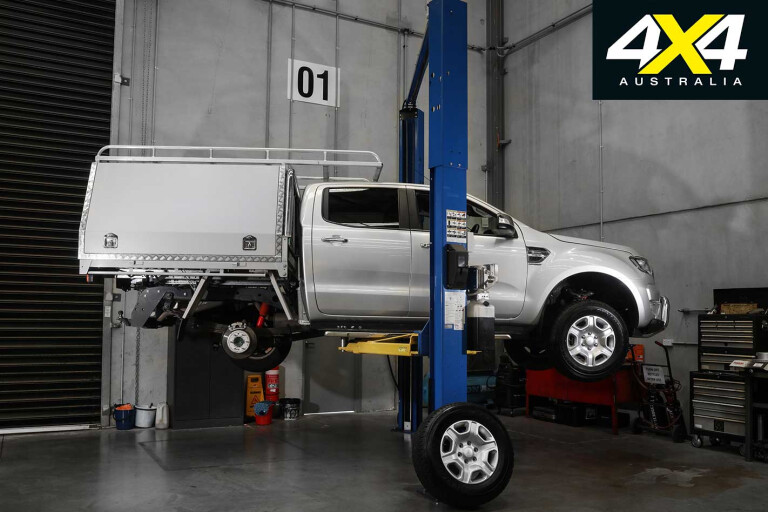
Looking at the kit in place with a few hundred kays of Melbourne-winter road grime plastered on, it’s difficult to pick the Pedders setup from what you’d imagine a Ranger with a factory disc rear-end would look like. And to drive it is kind of more of the same.
The vehicle we sampled was a heavily loaded Ranger dual cab with a service-body full of air-conditioning gear onboard, so the weight distribution would be well rearward of that of a stock, unladen Ranger 3.2. But, of course, that also makes it a prime candidate for this modification.
Based on either pedal feel, brake noise or smoothness in normal driving, there’s no real apparent difference (which in reality is a compliment in itself). But when the chips are down, the disc-braked vehicle will always perform much better.
In the end, that’s the point, in a way: while it’s a relatively costly modification at $2370 plus fitting, if you don’t want to do it yourself, this is not something that’s going to appeal to dual-cab owners chasing bling or glory. However, if you really do work your ute, whether that’s on-road with a big load or off-road where the traction aids need to do their stuff, then this could be money very well spent indeed.
RATED
Available from: www.pedders.com.au
RRP: $2370 (excl. fitment)
We Say: Worthwhile upgrade for improved braking performance
GVM Lift
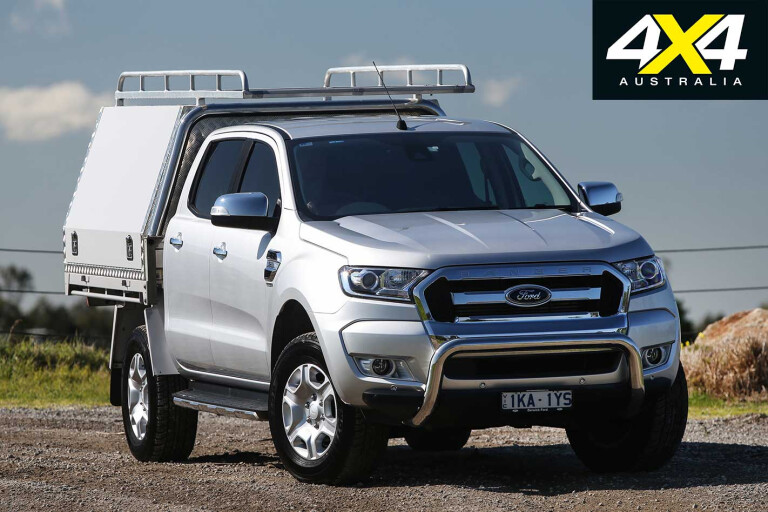
THE RANGER we drove for this look-see also had one of Pedders’ GVM+ suspension kits fitted, which gives a bit more payload headroom to vehicles that often operate at or near their official GVM limit. There are currently 20 utes and vans that the Pedders GVM+ gear can offer a leg-up to and, in the case of the Ranger we sampled, the kit takes the GVM from 3200 to 3500kg.
In the Ranger’s case, the kit includes struts and coils, leaf rear springs, dampers, replacement U-bolts, shackle-pins and all the relevant bushes. The best news is that the whole shebang is certified by the Feds in Canberra, so there won’t be any legal or insurance blow-back.
Despite the weight our test car was packing the kit managed to maintain the ride quality these utes tend to develop as the load on the back increases, however, it managed to prevent the damping going to hell (as is often the case).
In fact, over a fairly lumpy section of bitumen, we found the Ranger was solid and stable at speed and makes an even better platform for the disc-brake conversion.

COMMENTS